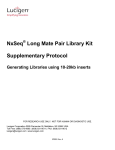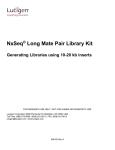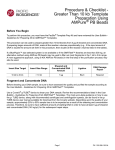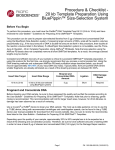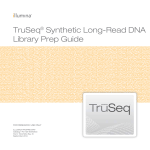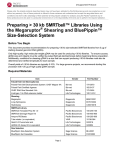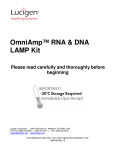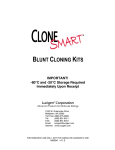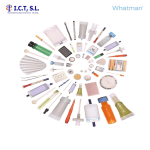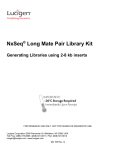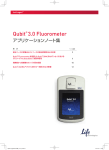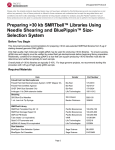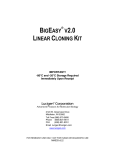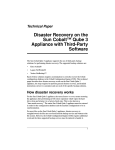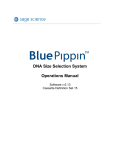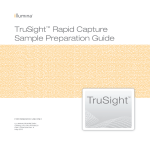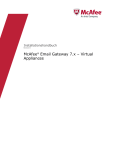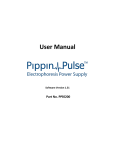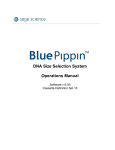Download NxSeq 20 kb Mate Pair Library Kit Protocol
Transcript
NxSeq® 20 kb Mate Pair Library Kit Protocol Generating Libraries using 10-20 kb inserts FOR RESEARCH USE ONLY. NOT FOR HUMAN OR DIAGNOSTIC USE. Lucigen Corporation 2905 Parmenter St, Middleton, WI 53562 USA Toll Free: (888) 575-9695 | (608) 831-9011 | FAX: (608) 831-9012 [email protected] www.lucigen.com SP001 Rev. C NxSeq® 20 kb Mate Pair Library Kit Protocol Product Description The NxSeq® Long Mate Pair Library Kit is designed to generate mate pair libraries for sequencing on Illumina platforms. This protocol describes the use of the NxSeq Long Mate Pair Library Kit reagents to generate mate pair libraries using 10-20 kb insert sizes. When combined with fragment library sequencing data, mate pair library sequences enable superior genome assembly, closure, and finishing. Applications include de novo genome assembly, chromosomal rearrangement detection, haplotyping, and BAC sequencing. In order to generate 10, 15, and 20kb libraries, the following reagents are required: Catalog # Description Kit Size 13000-1 NxSeq® Long Mate Pair Library Kit 5 libraries 13100-1 13200-1 13300-1 13400-1 NxSeq® Long Mate Pair Library and Index Kit NxSeq Long Mate Pair Library Index Kit NxSeq® Long Mate Pair Library Kit, Box 1 NxSeq® Long Mate Pair Library Kit, Box 2 5 libraries + 12 indices (5 libraries each) 12 indices, 5 libraries each 5 libraries 5 libraries 10-20 kb Protocol Workflow This protocol replaces steps 1-10 in the User’s Manual (MA160). After the completion of the protocol outlined in this document, users will return to the protocol in the User’s Manual (MA160). The restriction enzyme testing described in the User’s Manual is required prior to starting the 10-20 kb protocol outlined in this document. This protocol describes the use of two methods for step 5 (Size Selection); these methods include BluePippin Isolation and Gel Isolation using SeaKem Gold Agarose gels and Elutraps. Step 1 (Shearing) through step 4 (Ligation of Adaptor) and Step 6 (Ligation of Insert to Coupler) through Step 8 (Clean up) are the same regardless of the size selection method. Refer to this section in the standard protocol (MA160: NxSeq® Long Mate Pair Library Kit User’s Manual) for additional details on the overall mate pair library workflow. Page 2 of 27 SP001 Rev. C NxSeq® 20 kb Mate Pair Library Kit Protocol Components and Storage Store all kits and components at -20C NxSeq® Long Mate Pair Kit – Box 1 Reagent Name Elution Buffer End Repair Tailing Buffer1 End Repair Enzyme Mix1 Klenow Fragment Adaptor1 Ligase 1 Reagents only in Box 1 NxSeq® Long Mate Pair Kit – Box 2 Reagent Name Elution Buffer (EB) Klenow Fragment Ligase Coupler Mix 10X Ligase Buffer Nuclease 1 Nuclease 2 Biotin Wash Buffer Biotin Capture Buffer Biotin Capture Reagent Tailing Buffer Junction Code™ Reagent T4 Polynucleotide Kinase Accura HotStart 2X Master Mix Primer Mix, Index 12 # tubes in kit (A943016) 1 2 1 1 1 1 Cap Identifier EB ERB ERE KF ADT LIG Map Identifier # tubes in kit (A943018) 5 1 1 1 1 1 1 4 1 1 1 1 1 1 1 Cap Identifier EB KF LIG CM 10X N1 N2 BWB BCB BCR TB JC PNK AMM 12 Map Identifier EB: Elution Buffer ERB: E.R. Buffer ERE: E.R. Enzyme KF: Klenow ADT: Adaptor Lig: Ligase EB: Elution Buffer KF: Klenow LIG: Ligase CM: Coupler 10X: Ligase Buffer N1: Nuclease 1 N2: Nuclease 2 BWB: Biotin Wash BCB: Biotin Buffer BCR: Biotin Reagent TB: Tailing Buffer JC: Junction Code PNK AMM: Accura 2X MM 12: Index 12 Page 3 of 27 SP001 Rev. C NxSeq® 20 kb Mate Pair Library Kit Protocol Customer-Supplied Reagents and Equipment Note: The customer-supplied reagents and equipment vary depending on the size selection method. Reagent Recommended Vendor Catalog # SeaKem Gold Agarose 50X TAE agarose gel running buffer Lambda DNA- HindIII digest Lambda DNA Mono Cut Mix 3 M NaOAc pH7.0 100% Isopropanol GlycoBlue 10% SDS Solution Proteinase K Ethidium Bromide Solution at 10 mg/mL 10X Loading Dye Lonza Thermo Scientific 0.75% Agarose cassettes, Dye Free, Low Range S1 marker Loading solution 0.1% Tween 20 3 M Sodium Acetate 50152 B49 Used for 2-8 kb Protocol No No Blue Pippin (Step 5A) Yes Yes SeaKem / Elutrap (Step 5B) Yes Yes NEB N3012S No Yes Yes NEB N3019S No Yes Yes Ambion Various Ambion Ambion NEB Bio-Rad AM9740 Various AM9516 AM9822 P8107S 161-0433 No No No No No No Yes Yes Yes Yes Yes Yes Yes Yes Yes Yes Yes Yes Various Various No Yes Yes Sage Science BLF7510 No Yes No Sage Science Sage Science Sage Science Life Technologies * * * AM9740 No No No No Yes Yes Yes Yes No No No No R0620S Yes Yes Yes R0167S Yes Yes Yes R0137S Yes Yes Yes R0108S Yes Yes Yes B7204S (comes with Restriction Enzymes) 1002A Yes Yes Yes Yes Yes Yes A25653 Yes Yes Yes 65001 Yes Yes Yes A63881 or A63882 Yes Yes Yes HpyCH4V Restriction Enzyme RsaI Restriction Enzyme (10 U/µL) AluI Restriction Enzyme (10 U/µL) HaeIII Restriction Enzyme (10 U/µL) CutSmart™ Buffer NEB AccII Restriction Enzyme (10 U/µL) RsaI, AluI, HaeIII, AccII and RE Buffer Dynabeads MyOne Streptavidin C1 Agencourt AMPure XP Magnetic Beads Takara Life Technologies Life Technologies Beckman Coulter Page 4 of 27 SP001 Rev. C NxSeq® 20 kb Mate Pair Library Kit Protocol Reagent Recommended Vendor Catalog # Used for 2-8 kb Protocol Yes Yes Blue Pippin (Step 5A) Yes Yes SeaKem / Elutrap (Step 5B) Yes Yes Yes Yes Yes Yes Yes Yes Yes Yes Used for 2-8 kb Protocol No Blue Pippin (5A) Yes SeaKem /Elutrap (5B) Yes No Yes Yes 100% Ethanol Various Various Nuclease Free Water Ambion AM993 (not DEPC-treated) 1.5 mL Eppendorf DNA Eppendorf 22431021 Yes LoBind Microcentrifuge tubes 0.2 mL thin wall PCR Various Various Yes tubes Qubit® dsDNA HS Assay Invitrogen Q32854 Yes Kit Bioanalyzer DNA Kits. Agilent 5067-4626 Yes Options include Technologies 5067-1508 Agilent High Sensitivity DNA Kit Agilent DNA 12000 Kit (optional) *Included with 0.75% Agarose cassettes, Dye Free, Low Range. Equipment Recommended Catalog # Vendor Wide Bore Pipet Tips 200 µL Wide Bore Pipet Tips 1000 µL Eppendorf Centrifuge Electrophoresis supplies: SeaKem Gold Agarose Markers (1K plus and 100 bp) Marker (Lambda DNA HindIII digest) Marker (Lambda DNA Mono Cut Mix) Covaris g-TUBE™ Axygen Refrigerator 4C° (calibrated to 4 – 5°C) TF-205-WB-LR-S TF-1005-WBR-S Axygen Eppendorf Various Lonza Lucigen NEB NEB 5424 Various 50152 50020-1 or 50010-1 N3012S N3019S No No No Yes Yes Yes Yes Yes Yes Covaris No Yes Yes Various 520079 or 520104 Various No Yes Yes BluePippin Sage Science n/a No Yes No Elutrap Long wave UV 365 nM (Blak-Ray Lamp) Whatman UVP, Inc 10 447 700 Model UVL56 No No No No Yes Yes Page 5 of 27 SP001 Rev. C NxSeq® 20 kb Mate Pair Library Kit Protocol Equipment Recommended Catalog # Vendor 2100 Bioanalyzer Electrophoresis supplies: Agarose Markers (1K plus and 100 bp) Agilent Various Various Various Lucigen 50020-1 or 50010-1 Used for 2-8 kb Protocol Yes Yes Blue Pippin (5A) Yes Yes SeaKem /Elutrap (5B) Yes Yes Yes Yes Yes Prior to starting: Restriction Enzyme Selection Before proceeding with library construction, you must identify the restriction enzyme(s) needed to digest the gDNA to 400–900 bp (desired final library after PCR amplification). This step is critical to ensure the kit performs as designed and the sequencing coverage is uniform. Refer to this section in the standard protocol (MA160: NxSeq® Long Mate Pair Library Kit User’s Manual) for detailed instructions. General Recommendations Use Eppendorf Lo-Bind 1.5 mL tubes throughout the protocol. Thaw all kit reagents on ice prior to use. Use wide bore tips to handle High Molecular Weight DNA Use a Qubit Fluorometer or equivalent to perform all sample quantification throughout the protocol. o The ratios of material used in each ligation step throughout the protocol have been optimized for the best performance. o The materials provided in the kit are quantified using Qubit® 2.0 Fluorometer (Life Technologies). o The use of other quantification methods (e.g. gel image, A260/A280), may lower the efficiency of the kit and result in insufficient material to sequence. Detailed Protocol 1. Shear DNA to Appropriate Size During this step, the genomic DNA (gDNA) is sheared to an average size range that is larger than the desired insert size. See Appendix B: The effect of the size range of sheared DNA on insert size for additional information on shearing and size selection. Notes: gDNA used must be free of contaminating RNA. gDNA used must be of a high molecular weight (>20 kb). gDNA must be resuspended in Low TE (0.1 mM EDTA; 10 mM Tris pH 8) or in 10 mM Tris pH 8.5. Tagmentation from Illumina should not be used for shearing., Tagmentation will add additional nucleotides, and the use of Tagmentation has not been tested with the mate pair kit. Page 6 of 27 SP001 Rev. C NxSeq® 20 kb Mate Pair Library Kit Protocol A sample loss of 20-60% is expected during shearing and clean up. The percentage of sample loss will vary depending on the shearing method used. This expected loss should be taken into account when determining the amount of gDNA to shear. Use the table below to determine the recommended amount of starting gDNA and shearing method for your final desired insert size. Final Desired insert size Recommended amount of starting material 10kb 15 µg in 150 µL Elution Buffer (EB) 15kb 15 µg in 150 µL Elution Buffer (EB) 20 kb 15 µg in 150 µL Elution Buffer (EB) Recommended shearing conditions g-TUBE™; 6200 RPM for 2 minutes each orientation using an Eppendorf model 5424 Centrifuge g-TUBE™; 5500 RPM for 2 minutes each orientation using an Eppendorf model 5424 Centrifuge g-TUBE™; 4500 RPM for 3 minutes each orientation using an Eppendorf model 5424 Centrifuge 1.1 Options for shearing Covaris g-TUBE™ (Covaris, Woburn, MA) 1.2 Size confirmation of sheared gDNA Confirm the correct size of the sheared gDNA: o Visualize on a 0.3 % SeaKem Gold agarose gel in 1X TAE buffer; 70 V, 75 minutes. Use the λ-HindIII and λ–Monocut ladders (See Figure 2 for example gel image). 1.3 Quantification of Sheared gDNA Quantify the sample from step 1.3 Purified, Sheared gDNA using Qubit® dsDNA HS Assay Kit with the Qubit® 2.0 Fluorometer according to manufacturer’s instructions. Minimum amount and concentration of DNA required to proceed: DNA should be in either Low TE (0.1 mM EDTA, 10 mM Tris pH 8) or 10 mM Tris pH 8.5. Insert Size Minimum Amount DNA Required Minimum Concentration DNA Required 10 kb 15 kb 15 µg for g-TUBE™ shearing* ≥ 100 ng/µL 20 kb * More DNA might be needed, depending on DNA shearing method. Optional Safe Stopping Point: DNA can be stored at -20C. Page 7 of 27 SP001 Rev. C NxSeq® 20 kb Mate Pair Library Kit Protocol Figure 2. Sheared genomic DNA. Genomic DNA was sheared to approximately 28 kb with a gTUBE™ and visualized on a 0.3% SeaKem Gold agarose gel. Markers include: High Mass Ladder, Lambda-HindIII, Lambda genomic DNA, and Lambda Mono Cut Mix. Page 8 of 27 SP001 Rev. C NxSeq® 20 kb Mate Pair Library Kit Protocol 2. End Repair During this step, the sheared gDNA from step 1 is end-repaired. Each end-repair reaction is limited by the number of DNA molecules. Therefore, the number of reactions performed at this step is determined by the insert size: Insert Size 10 kb 15 kb 20 kb Recommended # of reactions 8 (938 ng each reaction) 16 (938 ng each reaction) 16 (938 ng each reaction) 2.1 NxSeq® Long Mate Pair Kit – Box 1 Reagents Reagent Cap Identifier End Repair Tailing Buffer ERB End Repair Enzyme Mix ERE 2.2 User-Supplied Reagents / Equipment Reagent Purified, Sheared gDNA Nuclease Free Water 0.2 mL thin wall PCR tubes Thermocycler Supplied By From step 1.4 Ambion Eppendorf User 2.3. Protocol Add the following reagents to 0.2 mL thin wall PCR tubes (number of reactions determined in table in step 2: End Repair). Reagent Amount (for each reaction) Purified, sheared gDNA 938 ng Nuclease-Free Water Up to 23 µL End Repair Tailing Buffer (ERB) 25 µL End Repair Enzyme Mix (ERE) 2 µL Total 50 µL Mix by pipetting up and down 10 times using a wide bore tip. Place tube(s) in a thermocycler and incubate according to the following parameters: Step 1 2 3 Temperature 25°C 72°C 4°C Time 20 minutes 25 minutes Hold Proceed directly to step 3: A-Tailing. Page 9 of 27 SP001 Rev. C NxSeq® 20 kb Mate Pair Library Kit Protocol 3. A-Tailing During this step, the End-Repaired gDNA from step 2.3 is A-tailed. The number of reactions performed during this step is the same as the number of reactions performed in step 2. End Repair. 3.1 NxSeq® Long Mate Pair Kit – Box 1 Reagents Reagent Cap Identifier Klenow Fragment KF 3.2 User-Supplied Reagents / Equipment Reagent End-repaired gDNA Thermocycler Supplied By From step 2.3 User 3.3 Protocol Using the tubes containing the End-repaired, sheared DNA, set up the A-tailing reaction; add each reagent in the following order. Reagent Volume (µL) (for each reaction) 50 2 52 End-repaired gDNA Klenow Fragment (KF) Total Mix by pipetting up and down 10 times with a wide bore tip. Place the tube in a thermocycler and incubate according to the following parameters: Step 1 2 3 Temperature 37°C 70°C 4°C Time 20 minutes 15 minutes Hold Proceed directly to step 4. Ligation of Adaptor. Page 10 of 27 SP001 Rev. C NxSeq® 20 kb Mate Pair Library Kit Protocol 4. Ligation of Adaptor During this step, the A-tailed gDNA from step 3.3 is ligated to the adaptor. NOTE: Do not vortex the adaptor. Mix by pipetting up and down and spin down briefly prior to use. 4.1 NxSeq® Long Mate Pair Kit – Box 1 Reagents Reagent Cap Identifier Adaptor ADT Ligase LIG 4.2 User-Supplied Reagents / Equipment Reagent A-tailed gDNA 10% SDS Solution Proteinase K 3 M NaOAc pH7 100% Isopropanol GlycoBlue Thermocycler Supplied By From step 3.3 Ambion NEB Ambion Various Ambion User 4.3 Ligation In the tube with the A-tailed gDNA, set up the ligation reactions; add each reagent in the following order. Reagent Volume (µL) (for each reaction) 52 6 4 62 A-tailed gDNA Adaptor (ADT) Ligase (LIG) Total Mix by pipetting up and down 10 times with a wide bore tip. Place tube in the a thermocycler and incubate according to the following parameters: Step 1 2 Temperature 25°C 4°C Time 30 minutes Hold Spin the tubes briefly to collect materials at the bottom of the tubes. Pool ligation reactions o For 10kb libraries, pool reactions 1-8 into clean 1.5 mL LoBind tubes. o For 15 and 20kb libraries, pool reaction 1-8 and 9-16 into two clean 1.5 mL LoBind tubes. Page 11 of 27 SP001 Rev. C NxSeq® 20 kb Mate Pair Library Kit Protocol Calculate the total volume of pooled ligation reactions and record the value. Reagent Volume (µL) Volume (µL) Volume (µL) (for each reaction) (reactions 1-8) (reactions 9-16) Ligated Material 62 496 496 10% SDS Solution 4 32 32 Proteinase K 4 32 32 Total 70 560 560 Mix by inverting tube 10 times. Spin briefly to collect material in the bottom of the tube. Place tube in the thermomixer or heat block and incubate according to the following parameters: Step 1 Temperature 37°C Time 30 minutes 4.4 Precipitate Ligated Material In the tube containing the material treated with Proteinase K, set up the precipitation reactions; add each reagent in the following order. Reagent Proteinase K treated DNA 3 M NaOAc GlycoBlue 100% Isopropanol Volume (µL) (reactions 1-8) 560 56 1 900 Volume (µL) (reactions 9-16) 560 56 1 900 Mix by inverting tube 10 times. Incubate at Room Temperature for 10 minutes Centrifuge at Room Temperature (25°C) for 30 minutes at 15000 RPM. Note: SDS will precipitate at lower temperatures. Remove supernatant being careful not to disturb the blue pellet. Immediately add 600 µL of 70% Ethanol. Centrifuge at Room Temperature for 5 minutes at 15000 RPM. Remove supernatant with a pipette while being careful not to disturb the pellet. Air dry for 10minutes. For each tube, resuspend the pellet in: o 60 µL Elution Buffer (EB) with a wide bore tip for the BluePippin protocol in Section 5A. o 50 µL Elution Buffer (EB) with a wide bore tip for the SeaKem / Elutrap protocol in Section 5B. Incubate the eluted sample for 15 min at Room Temperature. Centrifuge at high speed (12,000-15,000 rpm) for 5 minutes to remove insoluble material. Transfer and pool the supernatants into a single, clean 1.5 mL LoBind tube. Page 12 of 27 SP001 Rev. C NxSeq® 20 kb Mate Pair Library Kit Protocol 5A. Size-select the Adaptor-Ligated DNA with BluePippin During this step, the Precipitated Insert with Ligated Adaptor from step 4.4 is cleaned up using the BluePippin. 5A.1 NxSeq® Long Mate Pair Kit – Box 1 Reagents Reagent Cap Identifier Elution Buffer EB 5A.2 Reagents / Equipment Needed Reagent Precipitated Insert with Ligated Adaptor BluePippin 0.75% Agarose cassettes, Dye Free, Low Range S1 marker Loading solution 0.1% Tween 20 3 M Sodium Acetate 100% Isopropanol 70% Ethanol (Prepare fresh daily) 1.5 mL LoBind Microcentrifuge tubes Ethidium Bromide Solution 10 mg/mL 10X Loading Dye Supplied By From step 4.4 Sage Science Sage Science Sage Science Sage Science Sage Science Ambion User User Eppendorf BioRad Various 5A.3 BluePippin Size Selection Prepare the 0.75% agarose dye free cassette according to the following instructions: o Gently tap any bubbles out from behind the elution modules. o Remove electrophoresis buffer from all five elution modules and replace it with fresh electrophoresis buffer. o Seal the elution modules shut with the provided tape. o Ensure that the buffer level is sufficient in all chambers. o Fill each sample well completely with electrophoresis buffer, and then remove 40 μL from each well. o Calibrate the instrument and test the cassette. Do not use any lanes that fail. Prepare the insert for loading onto the BluePippin o Add: 10 kb: 20 µL of BluePippin loading solution to the tube containing 60 µL of resuspended insert DNA. Do not vortex to mix. 15 and 20 kb: 40 µL of BluePippin loading solution to the tube containing 120 µL of resuspended insert DNA. Do not vortex to mix. o o Mix by pipetting up and down (about 10 times) with a wide bore pipet tip until the sample is equilibrated with loading solution. Spin the tube briefly to collect materials at the bottom of the tubes. Load the cassette with 40 μL of S1 marker in one lane, designated as the reference lane. Page 13 of 27 SP001 Rev. C NxSeq® 20 kb Mate Pair Library Kit Protocol Using a wide bore tip, load 40 μL of the resuspended insert DNA plus loading solution into each of the following lanes: o o For 10kb insert: Two of the four remaining lanes. For 15 and 20kb inserts: Four remaining lanes. NOTE: This protocol is optimized for 3-4 μg of DNA loaded per lane. If your amount of input DNA is outside of this range, additional optimization may be required. Under the Protocol Editor tab, program the BluePippin run with the following parameters: o Range Mode Settings: see table below o BluePippin Cassette Definition: see table below. o Indicate the reference lane loaded with the S1 marker by choosing the appropriate flag and select “apply reference to all lanes.” o For the four sample lanes, select the “range” box. o For the four sample lanes, enter the desired start value and a desired end value from the table below. Minimum Insert Size 10 kb 15 kb 20 kb Range Mode Settings BluePippin Cassette Definition Bpstart = 10000, Bpend = 50000 0.75%DF Marker S1 high-pass 6-10kb vs3 Bpstart = 15000, Bpend = 50000 Bpstart = 18000, Bpend = 50000 0.75%DF Marker S1 high-pass15-20 kb 0.75%DF Marker S1 high-pass15-20 kb Save the parameters as a named .pprot file. Under the Main tab, click on start. The required run time is dependent on the minimum insert size. For example, 10kb insert will take approximately 2 hours whereas a 20kb insert will take up to 4-5. After the run ends, allow the size selected samples to sit in the cassette for a minimum of 45 minutes. NOTE: Keeping the samples in the cassette for longer than 45 minutes increases the recovery of high molecular weight DNA samples from the elution modules. Samples can remain in the cassette for as long as 14-16 hours (overnight). Slowly extract the 40 μL size selected DNA samples from each of the two or four sample lane elution modules. o Use a regular 20-200 μL tip; wide bore tips will not fit in the elution module, o Do not pipet the samples up and down. Combine the two or four lanes for each sample into a single 1.5 mL Lo-Bind tube. To each of the two or four-sample lane elution modules, add 40 μL of 0.1% Tween 20. Page 14 of 27 SP001 Rev. C NxSeq® 20 kb Mate Pair Library Kit Protocol Allow the solution to sit in the elution module for 1 minute. Do not pipet the sample up and down. Gently and slowly extract the 40 μL sample from each sample lane elution module and add it into the 1.5 mL Lo-Bind tube for a total of ~160 uL for 1 0Kb samples and ~320 μL for 15 Kb and 20 Kb samples. 5A.4 Protocol: Precipitation of Captured Insert DNA In the tube with the size selected sample, set up the precipitation reaction; add each reagent in the following order. Reagent Volume (µL) Volume (µL) 10kb insert 15 and 20kb insert Insert DNA 160 320 3 M NaOAc, pH 7.0 (0.1X) 16 32 GlycoBlue 1 1 100% Isopropanol (1.5X) 240 480 Mix by inverting the tube 10 times. Incubate at -20°C for a minimum of 10 minutes up to overnight (14-16 hours). Centrifuge at 4°C for 30 minutes at 15,000 RPM. Remove supernatant being careful not to disturb the blue pellet. Immediately add 600 µL of 70% Ethanol. Centrifuge at 4°C for 5 minutes at 15,000 RPM. Remove supernatant with a pipette while being careful not to disturb the pellet. Air dry for 10 minutes. Carefully re-suspend the pellet in 50 µL Elution Buffer (EB). Incubate eluted sample for 15 min at RT. 5A.5 Concentration: Quantify using Qubit according to manufacturer’s instructions. Record the concentration in ng/µL. Confirm the minimum amount and concentration of DNA required to proceed. Insert Size 10 kb 15 kb 20 kb Minimum Amount DNA Required 500 ng 750 ng 1000 ng Minimum Concentration DNA Required 10.0 ng/µL 15.0 ng/µL 20.0 ng/µL Page 15 of 27 SP001 Rev. C NxSeq® 20 kb Mate Pair Library Kit Protocol 5A.6 Size: Confirm the correct size selection Visualize on 0.3% SeaKem Gold agarose gel. Run with Lambda DNA-HindIII digest (30 ng) and Lambda DNA Mono Cut Mix (200 ng). Bands at 10, 15, 17 and 23 kb should be visible (See Figure 3). Proceed directly to step 6: Ligation of Insert to Coupler. Figure 3. PFGE analysis of un-sheared genomic DNA, Sheared DNA and Size Selection with the BluePippin for inserts 20 kb and above. Page 16 of 27 SP001 Rev. C NxSeq® 20 kb Mate Pair Library Kit Protocol 5B. Insert Size Selection using SeaKem Gold Agarose and Elutrap™ During this step, the Precipitated Insert with Ligated Adaptor from step 4.4 is cleaned up using SeaKem Gold Agarose and Elutrap. 5B.1 NxSeq® Long Mate Pair Kit – Box 1 Reagents Reagent Cap Identifier Elution Buffer EB 5B.2 Reagents / Equipment Needed Reagent Precipitated Insert with Ligated Adaptor SeaKem Gold Agarose 50X TAE agarose gel running buffer Ethidium Bromide Solution 10 mg/mL Electrophoresis supplies 10X Loading Dye Elutrap 3 M NaOAc pH7.0 GlycoBlue 100% Isopropanol 1.5 mL LoBind Microcentrifuge tubes Supplied By From step 4.4 Lonza Thermo Scientific BioRad Various Various Whatman Ambion Ambion User Eppendorf 5B.3 Protocol: Agarose Gel Size Selection Prepare a SeaKem Gold agarose gel. o Add SeaKem Gold Agarose to 1X TAE according to the table below. Insert size SeaKem Gold 1X TAE (mL) Agarose (g) 10 kb 1.0 100 15 kb 0.5 100 20 kb 0.3 100 o o o Heat the TAE and agarose mixture to boiling to dissolve agarose. Cool the solution for 10 sec in a cold-water bath and add 15 µL of Ethidium Bromide (10 mg/mL). Pour into an electrophoresis casting tray (approximately 15 cm wide and 10 cm long) with a comb to form 1 cm X 2 mm wells. When polymerized, place agarose gel into an electrophoresis chamber containing 1X TAE buffer. Add: o 10 kb: 50 µL 10X Loading Dye to the 50 µL pooled, precipitated insert with ligated adaptors from step 4.4 (8 µg / tube). o 15 and 20 kb: 100 µL 10X Loading Dye to the 100 µL pooled, precipitated insert with ligated adaptors from step 4.4 (16 µg / tube). Load 50 µL sample into 2-4 internal wells (4 µg/well). Load 2.0 µL each Lambda DNA HindIII digest into two outer wells (approximately 1 µg). Page 17 of 27 SP001 Rev. C NxSeq® 20 kb Mate Pair Library Kit Protocol Run gel according to the table below: Insert size 10 kb 15 kb 20 kb Conditions 100 Volts; 60 minutes 100 Volts; 60 minutes 70 Volts; 75 minutes Note: Reversing electrode polarity for 20 seconds at 1 min and 30 min into the electrophoresis can help decrease small insert contamination. Excise the insert DNA band from the gel using a long wave UV hand held lamp and a single edge razor blade. o Cut the agarose gel at the lower edge of the Lambda HindIII 23 kb bands and make a second cut approximately 5 mm above the first cut. o Remove the approximately 1 cm X 5 mm agarose plugs containing the insert DNA, and place in a 1.5 mL tube (See example in Figures 4 and 5). Figure 4: Zone of Compression (ZOC). Inserts located in the Zones of Compression are excised for elution using the Elutrap™. Figure 5. Gel-Isolated Insert. Sheared, adapted insert was gel isolated on a 0.3% SeaKem Gold agarose gel. The marker is a Lambda-HindIII digest. The lower bands are un-ligated adaptor. Page 18 of 27 SP001 Rev. C NxSeq® 20 kb Mate Pair Library Kit Protocol 5B.4 Protocol: Elutrap Capture of Insert DNA Set up the Elutrap according to manufacturer’s instructions. Place two agarose plugs in the Elutrap next to the white BT2 filter (stacked horizontally or vertically side by side). 15 and 20 kb libraries require 2 Elutraps each. Apply 150 Volts for 5 hours. After electrophoresis, reverse the polarity of the electrodes and apply 200 Volts for 20 seconds to remove DNA from the BT1 membrane. Remove the buffer, containing the insert, from the sample chamber with a 1000 mL pipette tip and place into a fresh 1.5 mL LoBind tube (approximately 400 to 500 mL). Take care not to puncture the fragile white BT2 membrane. Note: The amount of sample removed will be variable. 5B.5 Protocol: Precipitation of Captured Insert DNA. Measure the volume of the sample removed from the sample chamber (X in table below). Split into two tubes if the volume of the mixture exceeds 1.5 mL. Add the following to the tube(s) containing the insert DNA. Reagent Volume Example #1 Volume (µL) Gel Excised Insert DNA (step 5B.3) X 400 3 M NaOAc, pH 7.0 (0.1X) 0.1 X 40 GlycoBlue 1 1 µL 100% Isopropanol (1.5X) 1.5X 660 Example #2 Volume (µL) 500 50 1 825 Mix by inverting the tube 10 times. Incubate at -20°C for a minimum of 10 minutes up to overnight (14-16 hours). Centrifuge at 4°C for 30 minutes at 15,000 RPM. Remove supernatant being careful not to disturb the blue pellet. Immediately add 600 µL of 70% Ethanol. Centrifuge at 4°C for 5 minutes at 15,000 RPM. Remove supernatant with a pipette while being careful not to disturb the pellet. Air dry for 10 minutes. Carefully re-suspend the pellet(s) using the following amounts of Elution Buffer (EB): o Single Tube: 50 µL o Two Tubes: 25 µL in each tube Incubate eluted sample for 15 min at RT. If sample is split into two tubes and resuspended in 25 µL of Elution Buffer (EB), pool tubes into clean 1.5mL tube. Page 19 of 27 SP001 Rev. C NxSeq® 20 kb Mate Pair Library Kit Protocol Combine 15 and 20 kb insert Elutrap samples (2 Elutraps each). 5B.5 Concentration: Quantify using Qubit according to manufacturer’s instructions Record the concentration in ng/µL. Confirm the minimum amount and concentration of DNA required to proceed, using the table below. Insert Size 10 kb 15 kb 20 kb Minimum Amount DNA Required 500 ng 750 ng 1000 ng Minimum Concentration DNA Required 10.0 ng/µL 15.0 ng/µL 20.0 ng/µL 5B.6 Size: Confirm the correct size selection: Visualize on 0.3% SeaKem Gold agarose gel. Run with Lambda DNA-HindIII digest (30 ng) and Lambda DNA Mono Cut Mix (200 ng). The 10, 15, 17 and 23 kb bands should be visible (See Figures 6 and 7). Proceed directly to step 6: Ligation of Insert to Coupler. Figure 6. Gel-Isolated Insert DNA. 20 kb insert DNA was gel-isolated on a 0.3% SeaKem Gold agarose gel and eluted with an Elutrap electro-eluter. Purified insert DNA was visualized on a 0.3% SeaKem Gold agarose gel. Markers include High Mass Ladder, Lambda-HindIII, Lambda genomic DNA, and Lambda Mono Cut Mix. Page 20 of 27 SP001 Rev. C NxSeq® 20 kb Mate Pair Library Kit Protocol Figure 7. Optional Method for Visualization: FIGE analysis of purified insert DNA. Insert DNA (arrow) was separated on a 0.6% agarose gel by Field Inversion Gel Electrophoresis using a BioRad CHEF-DR III System. 6. Ligation of Insert to Coupler During this step, the size-selected DNA with adaptor from step 5A.6 or 5B.6 is ligated to the coupler. 6.1 NxSeq® Long Mate Pair Kit – Box 2 Reagents Reagent Coupler Mix 10X Ligase Buffer Ligase Cap Identifier CM 10X LIG 6.2 User-Supplied Reagents / Equipment Reagent Size-selected DNA with Adaptor Nuclease Free Water Refrigerator (set at 4-5°C) Thermomixer or heat block (set at 70°C) Pipet designed for volumes under 2µL Supplied By From step 5A.6 or 5B.6 Ambion Various Eppendorf Various 6.3 Determine Amount of Insert Required Use the following equation to determine the amount of size-selected DNA with adaptor material is required for step 6.4 Protocol. NOTE: The optimal condition for this step is to use equal amounts of insert and coupler in the ligation reaction. The size of the coupler included in the kit is 2000 bp and the amount of coupler specified for each reaction is 100 ng. 𝒊𝒏𝒔𝒆𝒓𝒕 𝒔𝒊𝒛𝒆 𝒃𝒑 𝒙 𝟏𝟎𝟎 𝒏𝒈 = 𝒏𝒈 𝒊𝒏𝒔𝒆𝒓𝒕 = 𝒀 𝟐𝟎𝟎𝟎 𝒃𝒑 Example: 𝟓𝟎𝟎𝟎 𝒃𝒑 𝟐𝟎𝟎𝟎 𝒃𝒑 𝒙 𝟏𝟎𝟎 𝒏𝒈 = 𝟐𝟓𝟎 𝒏𝒈 6.3.1 Calculate and record the amount of insert required. Use the following equation to determine the required volume of size-selected DNA with adaptor required (X), based on the concentration determined in step 5A.5 or 5B.5 (Z) and the amount of insert (Y) in ng as calculated above. 𝒀 (𝐴𝑚𝑜𝑢𝑛𝑡 𝑖𝑛 𝑛𝑔) 𝑛𝑔 = 𝑿 𝒗𝒐𝒍𝒖𝒎𝒆 𝒊𝒏 𝒖𝑳 𝒁 (𝑪𝒐𝒏𝒄𝒆𝒏𝒕𝒓𝒂𝒕𝒊𝒐𝒏 𝒊𝒏 𝑢𝐿 ) 6.3.2 Calculate and record the volume of insert required (X volume in uL). Page 21 of 27 SP001 Rev. C NxSeq® 20 kb Mate Pair Library Kit Protocol 6.4 Protocol IMPORTANT NOTE: For 10 and 15 kb insert ligations, the insert will be ligated in a single tube. For 20 kb insert ligations, the insert will be split into two tubes with 500ng in each tube. In a single fresh 1.5 mL LoBind tube (10 and 15 kb) or two fresh 1.5 mL LoBind tubes (20 kb), set up the following ligation reactions to generate the Ligated Insert/Coupler; add each reagent in the following order. Reagents for 10 and 15 kb inserts Size-selected Insert with adaptor: Coupler mix (CM) Nuclease-free water 10X Ligase Buffer (10X) Ligase (LIG) Total Tube 1: Volume (µL) X (calculated in step 6.3.2) 3.0 Up to 356.5 40 0.5 400 Reagents for 20 kb inserts Size-selected Insert with adaptor: 500 ng each reaction Coupler mix (CM) Nuclease-free water 10X Ligase Buffer (10X) Ligase (LIG) Total Tube 1: Volume (µL) X/2 (calculated in step 6.3.2) Tube 2: Volume (µL) X/2 (calculated in step 6.3.2) 1.5 Up to 356.5 40 0.5 400 1.5 Up to 356.5 40 0.5 400 NOTE: Use a pipet designed for volumes under 2 µL to pipet the Ligase. Mix gently by inverting tube(s) 10 times. Incubate and heat kill the Ligated Insert/Coupler from step 6.4 according to the table below: Step 1 2 Temperature 4-5ºC 70ºC Time Overnight (14-16 hours) 15 minutes Place the tube(s) on ice for 2 minutes. Spin the tube(s) briefly to collect materials at the bottom of the tube(s). Proceed directly to Step 7: Exonuclease Treatment. Page 22 of 27 SP001 Rev. C NxSeq® 20 kb Mate Pair Library Kit Protocol 7. Exonuclease Treatment During this step the Heat Killed Ligated Insert/Coupler from step 6.4 is treated to remove any linear DNA. 7.1 NxSeq® Long Mate Pair Kit – Box 2 Reagents Reagent Cap Identifier Nuclease 1 N1 Nuclease 2 N2 7.2 Reagents / Equipment Needed Reagent Heat Killed Ligated Insert/Coupler Thermomixer or heat block (set at 37°C) Thermomixer or heat block (set at 80°C) Supplied By From Step 6.4. Eppendorf Eppendorf 7.3 Protocol In the tube(s) with the Heat Killed Ligated Insert/Coupler, set up the exonuclease treatment; add each reagent in the following order. Reagent Heat Killed Ligated Insert/Coupler Nuclease 1 (N1) Nuclease 2 (N2) Total Volume (µL) per Tube 400 7 5 412 Mix gently by pipetting up and down 10 times with a wide bore tip. Place tube(s) in a thermomixer or heat block and incubate according to the following parameters. Step 1 2 Temperature 37°C 80°C Time 30 minutes 30 minutes Place the tube(s) on ice for 2 minutes. Spin the tube(s) briefly to collect materials at the bottom of the tube(s). Proceed directly to Step 8: Clean-up of Exonuclease Treated Insert/Coupler. Page 23 of 27 SP001 Rev. C NxSeq® 20 kb Mate Pair Library Kit Protocol 8. Clean Up of Exonuclease Treated Insert / Coupler In this step, the Exonuclease Treated Insert/Coupler from step 7.3 is cleaned. 8.1 Protocol: Precipitation of Exonuclease treated Insert DNA. Add the following to the sample of Exonuclease Treated Insert / Coupler. Reagent Exonuclease Treated Insert / Coupler 3 M NaOAc (0.1X) GlycoBlue 100% Isopropanol Volume (µL) per Tube 412 41 1 680 Mix by inverting the tube(s) 10 times. Incubate at -20°C for a minimum of 10 minutes up to overnight (14-16 hours). Centrifuge at 4°C for 30 minutes at 15,000 RPM. Remove supernatant being careful not to disturb the blue pellet. IMPORTANT NOTE: Frequently the DNA is spread up the side of the tube and is difficult to see. Always add the Elution Buffer to the side of the tube and elute the DNA by washing the side of the tube until the DNA is resuspended. Immediately add 600 µL of 70% Ethanol. Centrifuge at 4°C for 5 minutes at 15,000 RPM. Remove supernatant with a pipette while being careful not to disturb the pellet. Air dry for 10 minutes. Carefully re-suspend the pellet(s) in a total of 35 µL Elution Buffer (EB) using a wide bore tip. For two tubes, add 17.5 µL Elution Buffer (EB) to each tube. Incubate eluted sample for 15 min at RT. For 20kb inserts, combine the two tubes into a clean 1.5mL Lo-bind tube for a total of 35 µL. Continue with Step 11: Restriction Enzyme Digest through Step 20 in the standard protocol (MA160: NxSeq® Long Mate Pair Library Kit User’s Manual) See Appendix A of this document for the expected size distribution of 20 kb inserts. Optional Safe Stopping Point: DNA can be stored at -20C. Page 24 of 27 SP001 Rev. C NxSeq® 20 kb Mate Pair Library Kit Protocol Appendix A. Size Distribution of 20kb Inserts Size distributions of sequenced 10, 15, and 20 kb Long Mate Pair Libraries are shown below. Qualified long span mate pairs were mapped against reference genomes, and the pair distance distribution was plotted in CLC Genomics Workbench. Figure 7: Size Distribution of 20 kb Insert Size Selected with BluePippin. Qualified long span mate pairs were mapped against the repeat masked reference genome GRCh38, and the pair distance distribution was plotted in CLC Genomics Workbench. High Pass; 20-50 kb range mode (35 kb selection); 15-20 kb definition, Marker S1. Figure 8: Size Distribution of 20kb Insert Size Selected with Elutrap. Sequencing data was mapped against the reference E. coli strain K12 and plotted as Paired Distance Distribution. Page 25 of 27 SP001 Rev. C NxSeq® 20 kb Mate Pair Library Kit Protocol Figure 9. 15 kb Mate Pair: E. coli, Elutrap. Figure 10. 10 kb Mate Pair: E. coli, Elutrap. Page 26 of 27 SP001 Rev. C NxSeq® 20 kb Mate Pair Library Kit Protocol Figure 11. 20 kb Mate Pair: Thermus aquaticus; Elutrap. Page 27 of 27 SP001 Rev. C



























